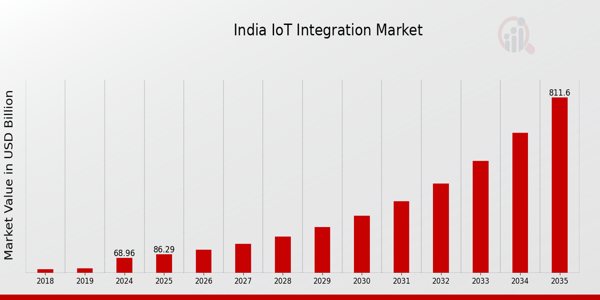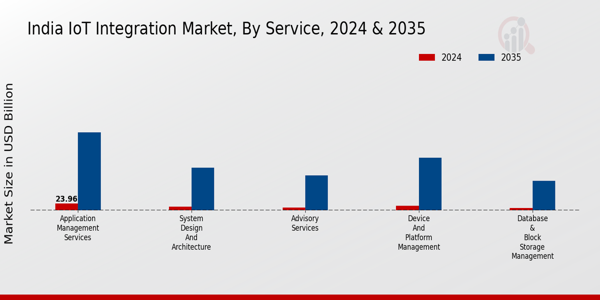India IoT Integration Market Overview
As per MRFR analysis, the India IoT Integration Market Size was estimated at 55.05 (USD Billion) in 2023.The India IoT Integration Market is expected to grow from 68.96(USD Billion) in 2024 to 811.59 (USD Billion) by 2035. The India IoT Integration Market CAGR (growth rate) is expected to be around 25.124% during the forecast period (2025 - 2035).
Key India IoT Integration Market Trends Highlighted
The market for IoT integration in India is expanding significantly due to a number of important factors, including as rising demand for smart devices, improved connectivity, and government programs supporting digital transformation. Initiatives like "Digital India," which aims to enhance digital infrastructure and connectivity throughout the nation, are actively supported by the Indian government.
In order to increase productivity, lower operating expenses, and improve consumer experiences, industries are progressively implementing IoT solutions. Advances in machine learning and artificial intelligence technologies that can be used with Internet of Things systems to enable automated decision-making and predictive analytics are among the market's opportunities.
Additionally, smart city initiatives are receiving increasing attention, which makes it easier to integrate IoT into public services, transportation networks, and urban infrastructure. Businesses now have a rare chance to create customized IoT solutions that meet the demands of industries including manufacturing, healthcare, and agriculture.
Current patterns show that established businesses and startups in India are increasingly working together to develop creative solutions and hasten the rollout of IoT applications. By offering quicker connectivity and more dependable communication channels, the growing use of 5G technology is also anticipated to expand the possibilities of IoT devices.
Additionally, there is a growing drive for sustainability, with businesses using IoT to optimize resources, minimize waste, and track and cut down on energy use. All things considered, these patterns demonstrate how IoT integration in India has the potential to revolutionize the nation and establish it as a major force in the global IoT scene.

Source: Primary Research, Secondary Research, Market Research Future Database and Analyst Review
India IoT Integration Market Drivers
Rapid Urbanization and Smart City Initiatives
India is undergoing rapid urbanization, with the Urban Population expected to reach 600 million by 2031 according to the Census of India. This transformation drives the demand for smart city solutions that incorporate Internet of Things (IoT) integration.
Established organizations such as Cisco and IBM are actively involved in implementing smart city projects in India, focusing on enhancing public safety, traffic management, and environmental monitoring. The Indian government's Smart City Mission aims to develop 100 smart cities across the country, with the potential to utilize IoT technologies extensively.
The integration of IoT in urban planning not only facilitates efficient resource utilization but also improves the quality of urban life, significantly contributing to the overall growth of the India IoT Integration Market.
Government Initiatives and Policies Supporting IoT
The Indian government has been proactive in promoting the Internet of Things through various initiatives, such as the Digital India campaign and Make in India. The Department of Telecommunications has released policy frameworks to support the growth of IoT technologies, reflecting a commitment to fostering innovation and investment.
This proactive government stance has helped attract investment from global tech giants like Microsoft and Google, aiming to develop IoT solutions tailored for Indian markets. Consequently, the conducive environment created by these initiatives is expected to drive the growth of the India IoT Integration Market.
Increased Demand for Automation Across Industries
The increasing demand for automation in various sectors, such as manufacturing, healthcare, and agriculture, is a significant driver of the India IoT Integration Market. Reports from the Ministry of Electronics and Information Technology indicate that automation can potentially improve operational efficiencies by up to 30%.
Major companies like Siemens and Bosch are investing heavily in India to deliver IoT solutions that enhance automation capabilities in production lines and supply chains. This trend not only boosts productivity but also reduces operational costs, thus propelling the adoption of IoT technologies across diverse industries within the India IoT Integration Market.
India IoT Integration Market Segment Insights
IoT Integration Market Service Insights
The Service segment of the India IoT Integration Market is integral to facilitating seamless connectivity and processing across various applications within the sector. Services related to Device and Platform Management are critical as they ensure the effective deployment and ongoing maintenance of connected devices, which are becoming ubiquitous across India’s industrial and consumer landscape.
This segment supports industries in managing vast networks of devices, thereby optimizing operational efficiency and enhancing data utilization. System Design and Architecture services are equally significant as they lay the foundation for integrating IoT solutions across multiple platforms.
Businesses rely on effective system design to address specific needs, subsequently driving innovation and functionality. Advisory Services contribute by providing expert guidance, helping organizations navigate the complexities of IoT adoption and maximize return on investments.As more companies in India adopt Internet of Things technologies, the demand for consulting expertise is poised to grow. Database and Block Storage Management services play a crucial role in handling the massive volumes of data generated by IoT devices.
As organizations strive to harness the full potential of their data, robust storage solutions become essential for ensuring quick access and processing, which in turn drives actionable insights. Application Management Services also stand out, allowing businesses to maintain the efficacy of their applications and ensuring they are constantly updated to meet changing market demands.
Additionally, Third Party API Management Services are noteworthy as they facilitate interoperability between disparate systems, which is vital in today's increasingly connected environment. The ability to integrate third-party APIs allows companies to enhance their IoT offerings and brings about innovative solutions, improving customer experiences significantly.
Overall, the Service segment represents a diverse range of offerings critical for the growth and efficiency of the IoT landscape in India. With the rising adoption of IoT technologies across sectors such as healthcare, automotive, and manufacturing, the need for comprehensive service solutions will continue to expand, making this segment pivotal in shaping the future of the India IoT Integration Market.

Source: Primary Research, Secondary Research, Market Research Future Database and Analyst Review
IoT Integration Market Organization Size Insights
The Organization Size segment of the India IoT Integration Market showcases a diverse landscape characterized by Large Enterprises and Small and Medium Enterprises (SMEs). Large Enterprises are increasingly adopting IoT integration to enhance operational efficiency and drive innovation, leveraging significant resources for technology adoption and integration.
This segment seeks to create comprehensive IoT ecosystems that align with their strategic goals, resulting in advanced analytics and streamlined processes. Conversely, Small and Medium Enterprises are embracing IoT solutions to maintain competitiveness and improve productivity, often focusing on specific applications tailored to their unique needs.
The government of India has been instrumental in fostering a conducive environment for SMEs through various initiatives, which facilitate access to technology and funding. Despite facing challenges such as budget constraints and technical expertise, SMEs hold a significant share in the market due to their agility and adaptability.
This dynamic interplay between Large Enterprises and SMEs shapes the organizational landscape within the India IoT Integration Market, reflecting a blend of innovation and practical applications tailored to the needs of different business sizes.As a result, the market dynamics continue to evolve, presenting opportunities for growth and strategic partnerships across both segments, essential for the broader industry growth trajectory.
IoT Integration Market Application Insights
The Application segment of the India IoT Integration Market plays a vital role in driving technological advancements across various sectors. Smart Healthcare is transforming patient care by implementing IoT devices for real-time monitoring and data analysis, leading to more personalized treatment plans.
In the Smart Retail domain, the adoption of IoT helps in enhancing customer experience through inventory management and personalized shopping experiences, significantly impacting sales and customer loyalty. The rise of Smart Building applications improves energy efficiency and reduces operational costs through smart management systems that track and optimize resource usage.
Meanwhile, Energy and Utilities leverage IoT solutions for smart grid management and real-time energy consumption monitoring, resulting in improved sustainability processes. Finally, Smart Transportation is gaining traction as it enhances logistics and fleet management, ultimately leading to reduced traffic congestion and improved safety.
The collective impact of these applications is crucial for fostering innovation and efficiency within the India IoT Integration Market, aligning with governmental initiatives aimed at boosting the digital economy. The ongoing trends in these sectors highlight their importance as catalysts for economic growth and improved quality of life in India.
India IoT Integration Market Key Players and Competitive Insights
The India IoT Integration Market is rapidly evolving, characterized by a dynamic landscape of competitive interactions that are shaping the future of various industries, including manufacturing, healthcare, agriculture, and smart cities.
Competitive insights in this market reveal a growing emphasis on technological advancements, strategic partnerships, and innovative solutions to effectively capitalize on the increasing demand for IoT services. Companies are leveraging their capabilities to provide seamless integration of IoT devices and platforms, which is essential in enhancing operational efficiency and optimizing resource utilization.
As businesses continue to adopt IoT technologies, market players are focusing on differentiating their offerings through enhanced security, data analytics, and user-centric solutions, thereby creating an intensely competitive environment that drives constant evolution and improvement.
In the context of the India IoT Integration Market, Tech Mahindra has established itself as a formidable player with a robust presence, leveraging its extensive experience in technology and consulting services. The company's strengths lie in its deep understanding of industry-specific requirements and its ability to deliver tailored IoT solutions that seamlessly integrate into existing systems.
Tech Mahindra has invested significantly in developing advanced analytics capabilities and partnerships with key technology providers, which enhances its ability to offer comprehensive, end-to-end IoT integration services.This strategic focus not only strengthens the company’s market position but also enables it to respond effectively to the diverse needs of its clients across various sectors, ensuring they harness the full potential of IoT technologies.
Key Companies in the India IoT Integration Market Include:
- Tech Mahindra
- Cognizant
- Cisco
- Capgemini
- Wipro
- Infosys
- Siemens
- HCL Technologies
- Tata Consultancy Services
- IBM
India IoT Integration Market Developments
Using 5th Gen Intel Xeon processors and GenAI agents to automate ticketing and network management, Tech Mahindra and Intel collaborated to create an AI-powered Digital Twin platform in July 2024 that optimizes capital expenditure budgeting for telecom operators.
Tech Mahindra introduced netOps.ai in February 2024, a network automation and orchestration framework that combines AI analytics and lifecycle management to speed up 5G adoption and IoT connectivity for service providers.
Cognizant strengthened its integration capabilities in early June 2024 by joining India's Tata Technologies IoT Engineering Lab in Ohio as a key partner, developing frameworks for IoT deployments in the automotive and industrial sectors. Wipro launched its Lab45 AI platform in 2024, integrating generative AI into business processes and IoT integration workflows for enterprise clients and utilities.
By spearheading the Industrial Internet Consortium's Asset Efficiency Testbed and integrating sensor data from the GE, Bosch, and IBM ecosystems to save energy and simplify maintenance, Infosys increased its footprint.
With the delivery of middleware, edge orchestration, analytics, and digital twin frameworks, Capgemini, HCL Technologies, TCS, Cisco, Accenture, Siemens, and IBM persisted in carrying out extensive IoT integration projects throughout India's manufacturing, transportation, utilities, and smart campus verticals.
By connecting device-level data with cloud-native platforms, artificial intelligence (AI), and scalable industrial services, these integrated solutions have aided in the transformation of India's digital infrastructure.
India IoT Integration Market Segmentation Insights
IoT Integration Market Service Outlook
- Device and Platform Management
- System Design and Architecture
- Advisory Services
- Database & Block Storage Management
- Application Management Services
- Third Party API Management Services
- Others
IoT Integration Market Organization Size Outlook
- Large Enterprises
- Small & Medium Enterprises
IoT Integration Market Application Outlook
- Smart Healthcare
- Smart Retail
- Smart Building
- Energy & Utilities
- Smart Transportation
| Report Attribute/Metric Source: |
Details |
| MARKET SIZE 2023 |
55.05(USD Billion) |
| MARKET SIZE 2024 |
68.96(USD Billion) |
| MARKET SIZE 2035 |
811.59(USD Billion) |
| COMPOUND ANNUAL GROWTH RATE (CAGR) |
25.124% (2025 - 2035) |
| REPORT COVERAGE |
Revenue Forecast, Competitive Landscape, Growth Factors, and Trends |
| BASE YEAR |
2024 |
| MARKET FORECAST PERIOD |
2025 - 2035 |
| HISTORICAL DATA |
2019 - 2024 |
| MARKET FORECAST UNITS |
USD Billion |
| KEY COMPANIES PROFILED |
Tech Mahindra, L&T Technology Services, Cognizant, Cisco, Capgemini, Rohde Schwarz, Wipro, Infosys, Siemens, Bosch, Toshiba, Samsung, HCL Technologies, Tata Consultancy Services, IBM |
| SEGMENTS COVERED |
Service, Organization Size, Application |
| KEY MARKET OPPORTUNITIES |
Smart city development projects, Industrial automation advancements, Healthcare IoT solutions expansion, Agriculture technology integration, Enhanced data analytics services |
| KEY MARKET DYNAMICS |
rising smartphone penetration, government initiatives, increasing enterprise demand, technological advancements, enhanced connectivity solutions |
| COUNTRIES COVERED |
India |
Frequently Asked Questions (FAQ):
The India IoT Integration Market is expected to be valued at 68.96 USD Billion in 2024.
By 2035, the India IoT Integration Market is projected to reach a value of 811.59 USD Billion.
The India IoT Integration Market is expected to achieve a CAGR of 25.124% from 2025 to 2035.
Device and Platform Management is expected to dominate with a market value of 15.0 USD Billion in 2024.
The market value of Application Management Services is projected to reach 266.59 USD Billion by 2035.
Key players in this market include Tech Mahindra, Cisco, IBM, and Tata Consultancy Services among others.
Advisory Services is anticipated to be valued at 10.0 USD Billion in the India IoT Integration Market by 2024.
The Database & Block Storage Management segment is projected to grow to 100.0 USD Billion by 2035.
Key growth drivers include increased connectivity, the rise of smart devices, and advancements in data analytics.
Challenges include data security concerns, interoperability issues, and the complexity of IoT ecosystems.
















